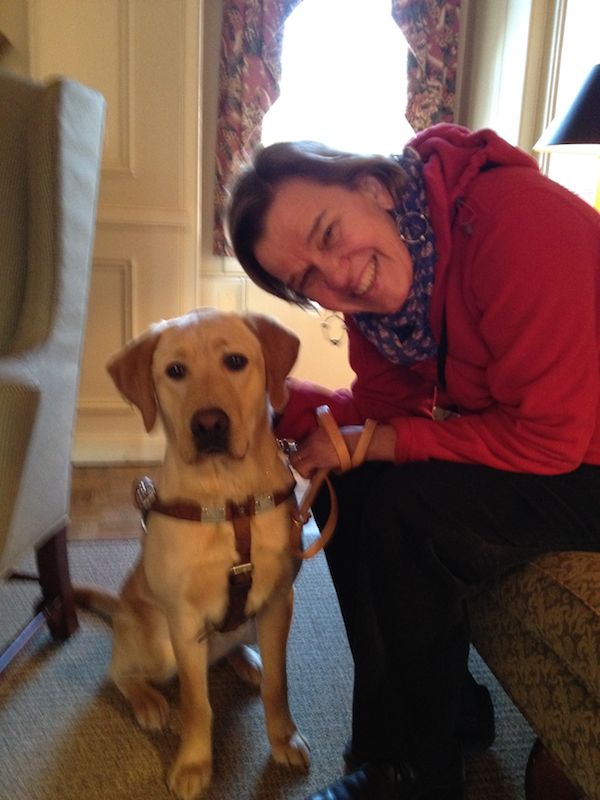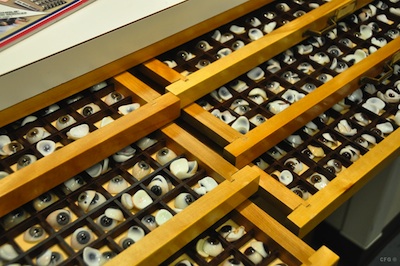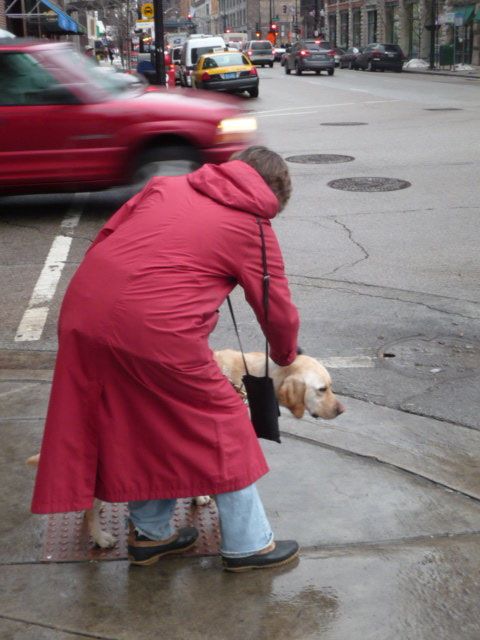Update: Active duty and retired canine soldiers
December 4, 2011 • 8 Comments • Posted in guide dogs, Seeing Eye dogs, UncategorizedIt’s Beth’s husband Mike here again, guest blogging for her while she’s at the Seeing Eye School in New Jersey. Beth and Whit are settling in — they did their first “solo” a couple days ago. Beth’s also learned that Whit plays fetch with devotion — if Whit brings it back and Beth can’t find it right away, all Beth needs to do is hold her open hand in front of her and Whit puts the toy of the moment in Beth’s open palm. And she does it again and again and…. She’s my new favorite.
My two old favorites are also thriving. I see Hanni nearly every week, because friends Steven and Nancy were not only kind enough to adopt Hanni, they adopt me for a couple days each week when I’m down in Urbana for work. I awake to the sound of Hanni’s tail thumping my bedroom door each morning. She’d been getting a little creaky — arthritis was taking a toll until the vet prescribed some anti-inflammatories. (Which, by the way, are administered with a dollop of liver sausage.) Voila! A near-12-year-old puppy is born! She’s one of a kind.
Harper’s suburban retirement is in full bloom, and he continues to make progress. From Chris, of Chris and Larry, his adoptive humans:
Harper has gotten pretty comfortable walking up and down our street without a leash — put one on and he goes back to anxious. He loves meeting new people and the dogs in the neighborhood. He and Beau (the collie next door) run around the yard like mad and have a great time playing together. We’re checking out a vet in Wheaton that the Burnham Animal Clinic recommended. This clinic’s website says they work with animals with behavior issues – I’m going to find out if they can help with PTSD. (Note: Burnham was Harper’s Chicago vet.)
It’s a joy to think about Harper and that Collie having carefree fun. And you read that right: PTSD. In earlier posts, I was reluctant to attribute Harper’s condition — after he and Beth’s frightening traffic encounter — as post traumatic stress disorder. It seems a trifle disrespectful to those humans suffering from it. And yet, from everything I’d read, Harper’s behavior did closely resemble it.
Well, the military thinks the same thing according to this story in the New York Times. (The link is worth visiting for the photo alone.)
From the story:
…the four-legged, wet-nosed troops used to sniff out mines, track down enemy fighters and clear buildings are struggling with the mental strains of combat nearly as much as their human counterparts.
Sounds kind of familiar. So does this:
Like humans with the analogous disorder, different dogs show different symptoms. Some become hyper-vigilant. Others avoid buildings or work areas that they had previously been comfortable in. Some undergo sharp changes in temperament, becoming unusually aggressive with their handlers, or clingy and timid. Most crucially, many stop doing the tasks they were trained to perform.
The idea that the vet Chris heard about might be able to treat PTSD sounds a little comical at first blush — an image of a German Shepherd on a therapist’s couch comes to mind — but the military has developed therapies for dogs that suffer for their experience. It’s effective enough that some dogs are re-deployed.
This is the kind of story that years ago, I probably would’ve said something like, “C’mon man, we’re talking about dogs here.” Now it doesn’t seem that simple. Beth and I and Steven and Nancy and now Chris and Larry have made fun of ourselves — and other “dog people” — for going on about the pooches. And we all know “cat people.” It’s the same. And really, it can bore the hell out of non-animal people, so let’s all agree to watch that.
These Labradors Beth brings home from New Jersey have made a dog person out of me, but its more than just that. Watching these creatures has convinced me we may have more in common than we don’t. And, watching their struggles — particular Harper’s plight — has made me more of a “person person.” Seeing what happened to him gives me all the more empathy for the folks in the military, in war zones, those who’ve survived the unthinkable in combat, accidents, or other calamities. Here’s to the hope that they all get as much care as Harper’s getting.




